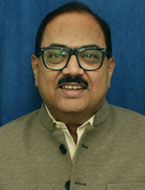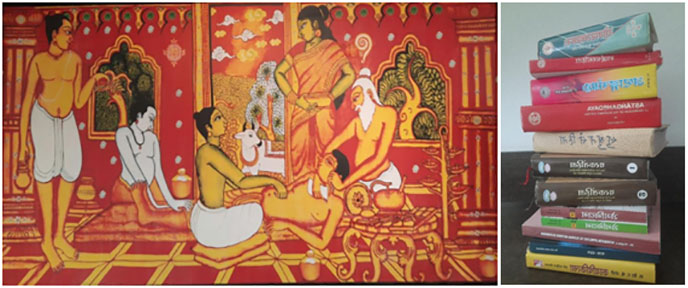The ancient Indian physician

Shrikant Wagh MD
Rheumatologist, Lupus Clinic, Pune, Dr D.Y. Patil College of Ayurved and Research Centre, Pune, Maharashtra, India.
The one who conquers ailments with medicines is known as a Bhishak (Rigveda). Relieving patients from their sufferings is equivalent to thousands of sacrificial rites (Mahabharat). In ancient times, there were wars, epidemics, and diseases, and there were physicians as well. Vedic literature contains various references to diseases such as leprosy, tuberculosis, blindness, and infertility. There is no place without people, and people are never completely healthy. Therefore, a good livelihood is always possible in this profession (Bhavmishra, AD 1600). One can earn money, make new friends, accumulate virtues (Punya), improve practical knowledge, and succeed (Vagbhat, AD 500).
Charak (200 BC) advised students to assess their inclinations, strengths, and weaknesses before entering a specific medical tradition. Students should then select a knowledgeable Guru, possesses practical experience, and has various other qualities. The selection of students for medical training is described by Charak and Sushrut (AD 100). Essential qualities included appropriate age, desire to gain knowledge, intelligence, good memory, decent behaviour, humility, and the ability to work hard. Training began with religious procedures (homa) and initial guidance on behaviour at the teacher’s school. Students were instructed to treat all patients as if they were treating their relatives.
There is no limit to the knowledge of life sciences. Therefore, even after completion of training, one should continue enhancing the depth of knowledge through continuous learning, teaching, and discussions with authorities at conferences (Sambhasha). Sushrut has also recommended learning contemporary sciences, as a single system is not adequate for scientific knowledge. In fact, Charak considers the whole world as a teacher.
Patient management has four pillars: the doctor, the nurse, drugs, and the patient himself. Like a captain of an army, he is the most important individual. There are four qualities of a good physician: proficiency in theoretical knowledge, extensive practical experience, dexterity, and purity (cleanliness of body and mind). Intelligence, logical thinking, ability, generosity, compassion, and restraint (avoid unnecessary treatments) are some additional qualities described by Bhel (100 BC) and Kashyap (AD 700). An attitude of continuous learning is a crucial quality that fosters successful clinical practice (Vagbhat).
Eight super specialities are described in Ayurvedic texts: medicine, surgery, paediatrics, geriatrics, and others. There were also veterinary doctors who treated respective animals according to hasti (elephant)-Ayurveda, ashva (horse)-Ayurveda, and so on. Charak has described three categories of physicians:
- Pseudo-physician: Does not know medical science but carries books, drugs, and equipment and dresses up like a Vaidya
- Pretending physician: One who poses like a knowledgeable and expert physician but is not so
- Genuine physician: A saviour of life with his deep knowledge and practicalskills
Manu Smriti advises punishment for quacks, while Kautilya (aka Chanakya) recommends mild, moderate, and severe punishments based on the severity of the patient’s damage.
Good memory, obedience, fearlessness (the courage to face the adversities of disease and treatments), and the ability to provide all information about the disease are qualities of a good patient (Charak). The medieval classics advise against the management of patients who are cowardly, too busy, adventurous, violent, or ungrateful. Moreover, Vagbhat advises refusing treatment to those who are in the bad books of the King and those who consider themselves doctors while indulging in self-medication.
Wealth as a quality of the patient was added later by Vagbhat. Money is essential for everything, including patient care. Patients are the bread and butter for all doctors (Hitopadesh), and doctors survive because there are patients (Mahabharat). Some seasons, such as summer, are the best for medical practitioners. One should never go empty-handed to a physician. A physician earns all the virtues of the patient if he does not pay for treatment.
However, serious diseases such as kshaya can destroy even the wealthiest people. Thus, contemporary literature always blames physicians for extracting money. An eloquent saying (subhashit) is, “O Vaidyaraj! we salute you. You are the brother of Yamaraj (God of Death). Yamaraj takes away pran (life), whereas you grab life and money too.”
Nevertheless, Sushrut says that patients in a house where a physician is not respected never get cured. Another subhashit states that when the body becomes diseased and frail, drugs are like the sacred water of the Ganga, and the Vaidya is like God Vishnu.
Further Reading:
- Charak-samhita (English translation) carakasamhitaonline.com
- Saini A. Physicians of ancient India. J Family Med Prim Care. 2016;5(2):254-58.
- Pandya B, Parmar N. Qualities of Physicians mentioned in Brhattrayi – A Review. Int. Ayu. Med. J. (online) 2017; 5 (7): 2635-44.


